Viking Grace Marks One Thousand LNG Bunkerings
From the very beginning, the Viking Grace – delivered in January 2013 – was an environmental milestone. The vessel attracted global attention as an environmental pioneer by being the first large passenger vessel to run on LNG. Now, three and a half years later, one thousand bunkerings have been performed in partnership with the Swedish company AGA Gas AB.
The M/S Seagas, which was specially built for ship-to-ship refuelling, has performed the bunkering after it entered service in January 2013. The Seagas supplies the Viking Grace with about 60 tons of LNG while the vessel is docked in the morning at Stadsgården in central Stockholm. The Seagas is the first vessel of its kind in the world and is classified according to the same regulations as for ocean-going LNG tankers.
 Viking Line’s wish was for bunkering to occur as quickly as possible, with no interruptions, with assured deliveries and without affecting cargo handling on the quay. With its safe LNG bunker solution using the Seagas, AGA could meet Viking Line’s needs. The safety aspect was also extremely important in this context.
Viking Line’s wish was for bunkering to occur as quickly as possible, with no interruptions, with assured deliveries and without affecting cargo handling on the quay. With its safe LNG bunker solution using the Seagas, AGA could meet Viking Line’s needs. The safety aspect was also extremely important in this context.
“We are really pleased about having used LNG to fuel the M/S Viking Grace”, says Jan Hanses, President and CEO of Viking Line Abp. “Both the technical solution developed by AGA and the vessel’s operation have outperformed expectations, and it is gratifying to note the major benefits for the workplace along with the environmental gains that running on LNG provides.”
Jonas Åkermark, who is in charge of the LNG marine market at AGA Gas AB, said: “There is still heavy interest in the Seagas, our ship-to-ship bunkering solution and LNG as a marine fuel both in Sweden and internationally. We have a well-functioning infrastructure solution in place in Stockholm and the possibility of bunkering more vessels.”
The Viking Grace was a trailblazer in the marine industry in 2013. There were many unanswered questions, including how the gas would actually be supplied to the vessel and the attitude of customers towards what, for them, was a new type of fuel. Among the steps it took to ensure it was well prepared, Viking Line put together factsheets about the properties of the gas.
The company expected some degree of skepticism, but in retrospect the response was incredibly positive. Viking Line received a very favorable response to the fuel alternative it had chosen and for the environmental values that the Viking Grace represented. International attention also exceeded all expectations.
